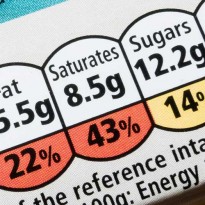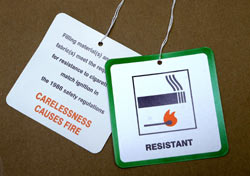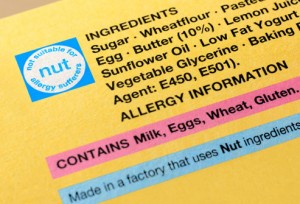Five labelling laws you need to be aware of
Posted on 23/10/2017 in Company News, by Jon

Whether you’re a food and drinks manufacturer or a furniture maker it’s so important to label your products to the exacting standards of the law.
From fire safety labels on a three-piece suit to an allergen label on a packet of chocolate, here are the five labelling laws you definitely need to know.
Fire safety labels on furniture
It’s the law to have two different kinds of labels on any type of furniture; display and permanent.
Display labelling is required to indicate the ignition resistance of each item of furniture and needs to be attached to all new furniture at the point of sale, except for mattresses, bed-bases, pillows, scatter cushions, seat pads, loose covers and stretch covers.
Display labels must be attached to the furniture in a prominent position so that the label will be clearly visible to a potential purchaser and the wording on both sides can be read with reasonable ease.
Display labels must also be applied to every single piece of furniture if sold in a collection, like a three-piece suite.
As well as display labelling, permanent labelling must be applied to all furniture too. These labels are used to assist enforcement officers and show compliance with the specific ignition requirements for covers and fillings, confirming that the materials used in the item comply with regulations.
Permanent labels need to be carried on all items of furniture except for mattresses divans and bed bases.

Allergen food safety labels
People with food allergies must be extremely careful about what they eat, that’s why food labelling is very important to them. There can be potentially profound consequences from eating food that they’re allergic to. Therefore, it’s crucial that food should be labelled correctly to ensure no one is hurt.
The law requires that all products are labelled with a comprehensive ingredient list, making it easier for people with food allergies to identify any ingredients they need to avoid.
However, there’s no legal requirement that states that labels must state, ‘may contain’ to show that there could be small amounts of an allergen in the product, for example milk, egg, nuts etc. This is because it has entered the product accidentally during the production process. While it isn’t a legal requirement, many manufacturers label their products in this way to warn their customers of this risk

Do not mislead people on your labelling
You don’t have to show certain information on the label for every kind of product, but if you choose to include it you must be accurate. There are special rules for some products, and for retailers.
It’s important that labels must not be misleading about things like quantity or size, the price, what it’s made of, how, where and when it was made, what you say it can do and the people or organisations that endorse it.
Using the CE mark
A CE mark is a manufacturer’s claim that their product meets the specified essential safety requirements set out in relevant European directives.
Certain categories of products must bear CE marking if you intend to sell them in the EU or member states of the European Economic Area (EEA) – Iceland, Liechtenstein and Norway.
There are many products that require the CE mark if you wish to sell them within the EU, including toys, medical devices, gas appliances, measuring instruments and electrical products.
The requirement for CE marking and the exact process you’ll need to go through varies from product to product. However, the responsibility for ensuring compliance with the regulations rests with the manufacturer of the machinery, equipment or components in question. Failure to do so can result in prosecution!
Units of measurement on labels
You must use metric measurements (grams, kilograms, millilitres or litres) on labels for packaged or loose goods in England, Scotland or Wales, however, there are different rules in Northern Ireland.
The only products you can sell in imperial measures are, draught beer or cider by pint, milk in returnable containers by pint and precious metals by troy ounce.
You can display an imperial measurement alongside the metric measurement on your label but it can’t stand out more than the metric measurement.

If you’re still unsure on product labelling, or need a new set of labels for your product, get in touch with us today! We can help you design and print your labels to the exacting standards of the law and create something both stylish and safe!

